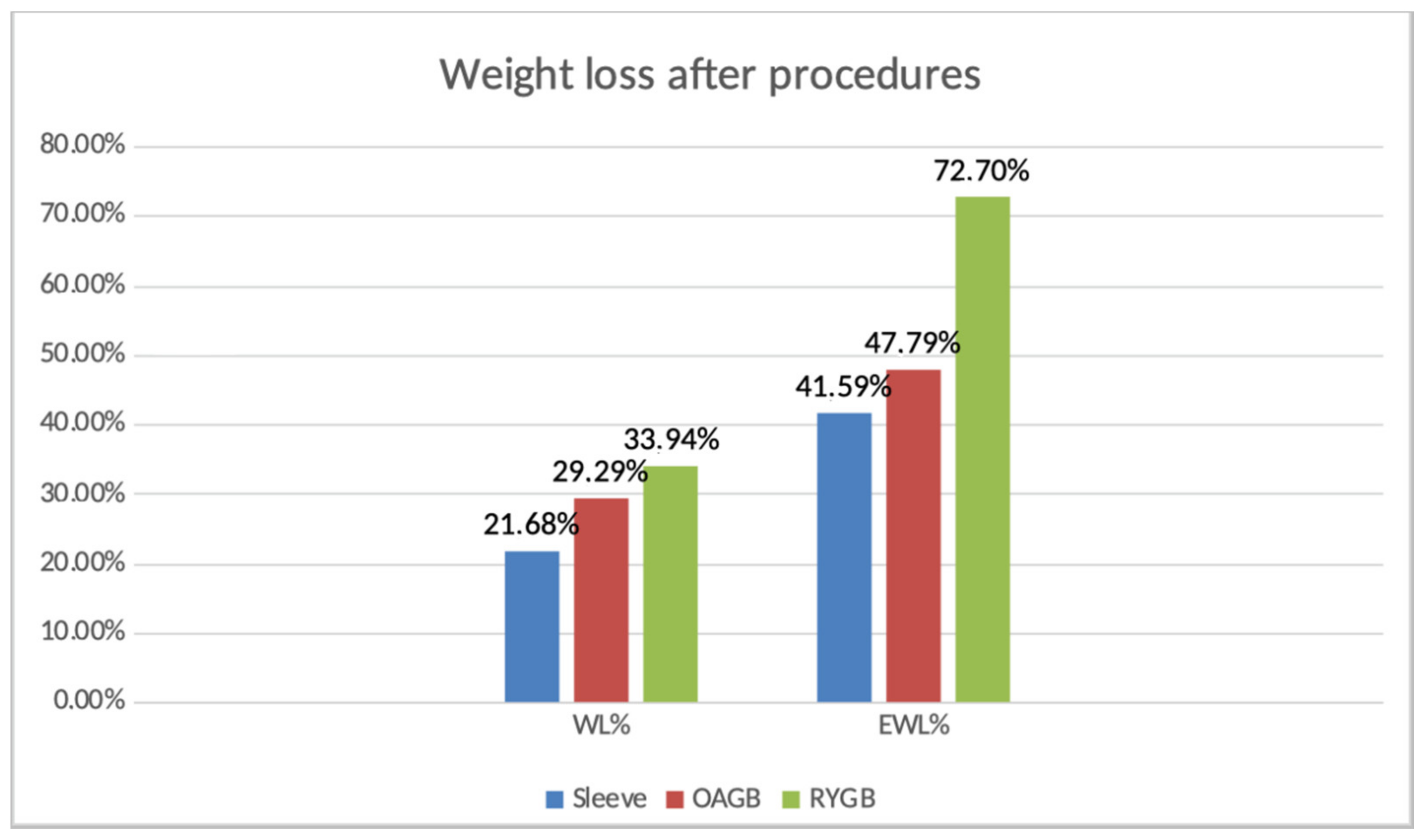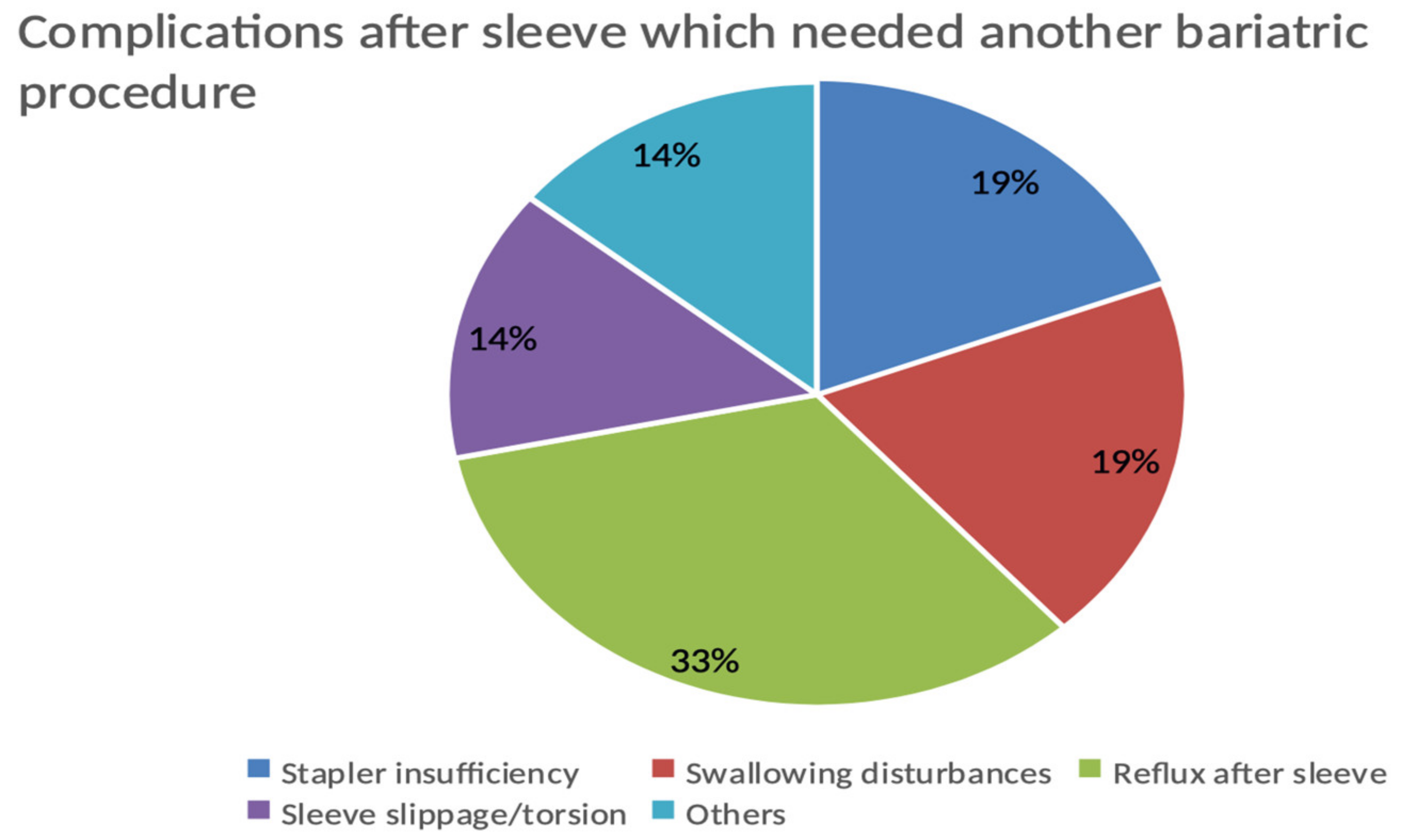Re-Do Surgery after Sleeve Gastrectomy: A Single Center Comparison between Roux-en-Y Gastric Bypass and One Anastomosis Gastric Bypass
Abstract
:1. Introduction
2. Methods
- primary surgery not performed in our center
- patients receiving a primary LSG after other bariatric procedure (e.g., adjustable gastric band)
3. General Operative Approach
4. Calculations and Statistics
5. Results
6. Discussion
7. Conclusions
Author Contributions
Funding
Institutional Review Board Statement
Informed Consent Statement
Data Availability Statement
Conflicts of Interest
References
- Hussain, A.; Mahawar, K.; El-Hasani, S. The Impact of COVID-19 Pandemic on Obesity and Bariatric Surgery. Obes. Surg. 2020, 30, 3222–3223. [Google Scholar] [CrossRef] [PubMed]
- Chiappetta, S.; Schaack, H.M.; Wölnerhannsen, B.; Stier, C.; Squillante, S.; Weiner, R.A. The Impact of Obesity and Metabolic Surgery on Chronic Inflammation. Obes. Surg. 2018, 28, 3028–3040. [Google Scholar] [CrossRef] [PubMed]
- Nascimento, G.P.D.; de Melo, H.A.B.; Faria, S.S.; Santos, I.D.O.; Kobinger, G.P.; Magalhães, K.G. Hypercoagulopathy and Adipose Tissue Exacerbated Inflammation May Explain Higher Mortality in COVID-19 Patients With Obesity. Front. Endocrinol. 2020, 11, 530. [Google Scholar] [CrossRef] [PubMed]
- Switzer, N.J.; Karmali, S.; Gill, R.S.; Sherman, V. Revisional Bariatric Surgery. Surg. Clin. 2016, 96, 827–842. [Google Scholar] [CrossRef]
- Mann, J.P.; Jakes, A.D.; Hayden, J.D.; Barth, J.H. Systematic Review of Definitions of Failure in Revisional Bariatric Surgery. Obes. Surg. 2015, 25, 571–574. [Google Scholar] [CrossRef]
- Brethauer, S.A.; Kothari, S.; Sudan, R.; Williams, B.; English, W.J.; Brengman, M.; Kurian, M.; Hutter, M.; Stegemann, L.; Kallies, K.; et al. Systematic review on reoperative bariatric surgery. Surg. Obes. Relat. Dis. 2014, 10, 952–972. [Google Scholar] [CrossRef]
- Van Rutte, P.W.J.; Smulders, J.F.; de Zoete, J.P.; Nienhuijs, S.W. Outcome of sleeve gastrectomy as a primary bariatric procedure. Br. J. Surg. 2014, 101, 661–668. [Google Scholar] [CrossRef]
- Langer, F.B.; Bohdjalian, A.; Shakeri-Leidenmuhler, S.; Schoppmann, S.F.; Zacherl, J.; Prager, G. Conversion from sleeve gastrectomy to Rouxen-Y gastric bypass—Indications and outcome. Obes. Surg. 2010, 20, 835–840. [Google Scholar] [CrossRef]
- Nedelcu, M.; Khwaja, H.A.; Rogula, T.G. Weight regain after bariatric surgery—How should it be defined? Surg. Obes. Relat. Dis. 2016, 12, 1129–1130. [Google Scholar] [CrossRef]
- Lauti, M.; Kularatna, M.; Hill, A.G.; MacCormick, A.D. Weight Regain Following Sleeve Gastrectomy—A Systematic Review. Obes. Surg. 2016, 26, 1326–1334. [Google Scholar] [CrossRef]
- Yu, Y.; Klem, M.L.; Kalarchian, M.A.; Ji, M.; Burke, L.E. Predictors of weight regain after sleeve gastrectomy: An integrative review. Surg. Obes. Relat. Dis. 2019, 15, 995–1005. [Google Scholar] [CrossRef] [PubMed]
- Sanchez, H.; Cabrera, A.; Cabrera, K.; Zerrweck, C.; Mosti, M.; Sierra, M.; Dominguez, G.; Herrera, M.F. Laparoscopic Roux-en-Y Gastric Bypass as a Revision Procedure after Restrictive Bariatric Surgery. Obes. Surg. 2008, 18, 1539–1543. [Google Scholar] [CrossRef] [PubMed]
- Suter, M.; Ralea, S.; Millo, P.; Allé, J.L. Laparoscopic Roux-en-Y Gastric Bypass After Failed Vertical Banded Gastroplasty: A Multicenter Experience with 203 Patients. Obes. Surg. 2012, 22, 1554–1561. [Google Scholar] [CrossRef] [PubMed] [Green Version]
- O’Brien, P.E.; Hindle, A.; Brennan, L.; Skinner, S.; Burton, P.; Smith, A.; Crosthwaite, G.; Brown, W. Long-Term Outcomes After Bariatric Surgery: A Systematic Review and Meta-analysis of Weight Loss at 10 or More Years for All Bariatric Procedures and a Single-Centre Review of 20-Year Outcomes After Adjustable Gastric Banding. Obes. Surg. 2019, 29, 3–14. [Google Scholar] [CrossRef] [Green Version]
- Apers, J.A.; Wens, C.; Van Vlodrop, V.; Michiels, M.; Ceulemans, R.; Van Daele, G.; Jacobs, I. Perioperative outcomes of revisional laparoscopic gastric bypass after failed adjustable gastric banding and after vertical banded gastroplasty: Experience with 107 cases and subgroup analysis. Surg. Endosc. 2013, 27, 558–564. [Google Scholar] [CrossRef]
- Landreneau, J.P.; Strong, A.T.; Rodriguez, J.H.; Aleassa, E.M.; Aminian, A.; Brethauer, S.; Schauer, P.R.; Kroh, M.D. Conversion of Sleeve Gastrectomy to Roux-en-Y Gastric Bypass. Obes. Surg. 2018, 28, 3843–3850. [Google Scholar] [CrossRef]
- Rutledge, R. The Mini-Gastric Bypass: Experience with the First 1274 Cases. Obes. Surg. 2001, 11, 276–280. [Google Scholar] [CrossRef]
- Musella, M.; Apers, J.; Rheinwalt, K.P.; Ribeiro, R.; Manno, E.; Greco, F.; Čierny, M.; Milone, M.; Di Stefano, C.; Guler, S.; et al. Efficacy of Bariatric Surgery in Type 2 Diabetes Mellitus Remission: The Role of Mini Gastric Bypass/One Anastomosis Gastric Bypass and Sleeve Gastrectomy at 1 Year of Follow-up. A European survey. Obes. Surg. 2015, 26, 933–940. [Google Scholar] [CrossRef]
- Lee, W.-J.; Chong, K.; Lin, Y.-H.; Wei, J.H.; Chen, S.C. Laparoscopic Sleeve Gastrectomy Versus Single Anastomosis (Mini-) Gastric Bypass for the Treatment of Type 2 Diabetes Mellitus: 5-Year Results of a Randomized Trial and Study of Incretin Effect. Obes. Surg. 2014, 24, 1552–1562. [Google Scholar] [CrossRef]
- Quan, Y.; Huang, A.; Ye, M.; Xu, M.; Zhuang, B.; Zhang, P.; Yu, B.; Min, Z. Efficacy of Laparoscopic Mini Gastric Bypass for Obesity and Type 2 Diabetes Mellitus: A Systematic Review and Meta-Analysis. Gastroenterol. Res. Pract. 2015, 2015, 152852. [Google Scholar] [CrossRef]
- Moszkowicz, D.; Rau, C.; Guenzi, M.; Zinzindohoué, F.; Berger, A.; Chevallier, J.M. Laparoscopic omega-loop gastric bypass for the conversion of failed sleeve gastrectomy: Early experience. J. Visc. Surg. 2013, 150, 373–378. [Google Scholar] [CrossRef] [PubMed]
- Bruzzi, M.; Voron, T.; Zinzindohoue, F.; Berger, A.; Douard, R.; Chevallier, J.M. Revisional single-anastomosis gastric bypass for a failed restrictive procedure: 5-year results. Surg. Obes. Relat. Dis. 2016, 12, 240–245. [Google Scholar] [CrossRef] [PubMed]
- Apers, J.; Wijkmans, R.; Totte, E.; Emous, M. Implementation of mini gastric bypass in the Netherlands: Early and midterm results from a high-volume unit. Surg. Endosc. 2018, 32, 3949–3955. [Google Scholar] [CrossRef] [PubMed]
- Lönroth, H. Laparoscopic Gastric Bypass. Obes. Surg. 1998, 8, 563–564. [Google Scholar] [CrossRef]
- Lee, W.-J.; Yu, P.-J.; Wang, W.; Chen, T.C.; Wei, P.-L.; Huang, M.-T. Laparoscopic Roux-en-Y versus mini-gastric bypass for the treatment of morbid obesity: A prospective randomized controlled clinical trial. Ann. Surg. 2005, 242, 20–28. [Google Scholar] [CrossRef]
- Lee, W.-J.; Wang, W.; Lee, Y.-C.; Huang, M.T.; Ser, K.H.; Chen, J.C. Laparoscopic Mini-gastric Bypass: Experience with Tailored Bypass Limb According to Body Weight. Obes. Surg. 2008, 18, 294–299. [Google Scholar] [CrossRef]
- Ruiz-Tovar, J.; Carbajo, M.A.; Jimenez, J.M.; Castro, M.J.; Gonzalez, G.; Ortiz-De-Solorzano, J.; Zubiaga, L. Long-term follow-up after sleeve gastrectomy versus Roux-en-Y gastric bypass versus one-anastomosis gastric bypass: A prospective randomized comparative study of weight loss and remission of comorbidities. Surg. Endosc. 2018, 33, 401–410, Retraction in Surg. Endosc. 2021, 35, 1492. [Google Scholar] [CrossRef]
- Rheinwalt, K.P.; Plamper, A.; Rückbeil, M.V.; Kroh, A.; Neumann, U.P.; Ulmer, T.F. One Anastomosis Gastric Bypass–Mini-Gastric Bypass (OAGB-MGB) Versus Roux-en-Y Gastric Bypass (RYGB)—A Mid-Term Cohort Study with 612 Patients. Obes. Surg. 2020, 30, 1230–1240. [Google Scholar] [CrossRef]
- Trotta, M.; Ferrari, C.; D’Alessandro, G.; Sarra, G.; Piscitelli, G.; Marinari, G.M. Enhanced recovery after bariatric surgery (ERABS) in a high-volume bariatric center. Surg. Obes. Relat. Dis. 2019, 15, 1785–1792. [Google Scholar] [CrossRef]
- Stenard, F. Laparoscopic sleeve gastrectomy and gastroesophageal reflux. World J. Gastroenterol. 2015, 21, 10348–10357. [Google Scholar] [CrossRef]
- Felsenreich, D.M.; Langer, F.B.; Bichler, C.; Eilenberg, M.; Jedamzik, J.; Kristo, I.; Vock, N.; Gensthaler, L.; Rabl, C.; Todoroff, A.; et al. Roux-en-Y Gastric Bypass as a Treatment for Barrett’s Esophagus after Sleeve Gastrectomy. Obes. Surg. 2020, 30, 1273–1279. [Google Scholar] [CrossRef] [PubMed] [Green Version]
- Csendes, A. Bile Reflux After One Anastomosis Gastric Bypass. Obes. Surg. 2020, 30, 2802–2803. [Google Scholar] [CrossRef] [PubMed]
- Hasenberg, T.; Niedergethmann, M. Redo-Eingriffe und Komplikationsmanagement in der bariatrischen Chirurgie. Der Chir. 2014, 85, 643–654. [Google Scholar] [CrossRef] [PubMed]
- Kermansaravi, M.; Shahmiri, S.S.; DavarpanahJazi, A.H.; Valizadeh, R.; Berardi, G.; Vitiello, A.; Musella, M.; Carbajo, M. One Anastomosis/Mini-Gastric Bypass (OAGB/MGB) as Revisional Surgery Following Primary Restrictive Bariatric Procedures: A Systematic Review and Meta-Analysis. Obes. Surg. 2021, 31, 370–383. [Google Scholar] [CrossRef] [PubMed]
- Grönroos, S.; Helmiö, M.; Juuti, A.; Tiusanen, R.; Hurme, S.; Löyttyniemi, E.; Ovaska, J.; Leivonen, M.; Peromaa-Haavisto, P.; Mäklin, S.; et al. Effect of Laparoscopic Sleeve Gastrectomy vs Roux-en-Y Gastric Bypass on Weight Loss and Quality of Life at 7 Years in Patients With Morbid Obesity. JAMA Surg. 2021, 156, 137. [Google Scholar] [CrossRef] [PubMed]
- Jain, M.; Tantia, O.; Goyal, G.; Chaudhuri, T.; Khanna, S.; Poddar, A.; Majumdar, K.; Gupta, S. LSG vs MGB-OAGB: 5-Year Follow-up Data and Comparative Outcome of the Two Procedures over Long Term—Results of a Randomised Control Trial. Obes. Surg. 2021, 31, 1223–1232. [Google Scholar] [CrossRef] [PubMed]



| Sleeve in OAGB | Sleeve in RYGB | |
|---|---|---|
| (n = 17) | (n = 46) | |
| Height | 165 cm | 166 cm |
| Weight before | 169.82 kg | 131.58 kg |
| Sleeve | (133.0–240.1) | (94.2–183.4) |
| BMI before Sleeve | 62.05 kg/m2 | 47.23 kg/m2 |
| (48.18–85.03) | (31.74–65.54) | |
| Years between first | 3 y 10 m | 1 y 7 m |
| Op and Re-Op Weight before Re-Op | 139.35 kg | 97.13 kg |
| BMI before Re-Op | 50.72 kg/m2 | 34.88 kg/m2 |
| (39.14–63.26) | (23.45–56.08) |
| Comorbidities | Sleeve in OAGB | Sleeve in RYGB |
|---|---|---|
| Arterial Hypertension | 29% | 36% |
| Diabetes Mellitus Type 2 | 23% | 17% |
| Asthma | 11% | 15% |
| Obstructive Sleep Apnea | 17% | 11% |
| Dyslipidemia | 17% | 21% |
| Arthrosis | 58% | 45% |
| Depression | 29% | 39% |
| Gastroesophageal Reflux Disease | 23% | 45% |
| Hypothyroidism | 29% | 23% |
| After Sleeve | After OAGB | |
|---|---|---|
| Delta BMI | 11.32 | 6.92 |
| WL | 17% | 29% |
| EWL | 28% | 47.7% |
| After Sleeve | After RYGB | |
|---|---|---|
| Delta BMI | 12.34 | 3.77 |
| WL | 25% | 33% |
| EWL | 54% | 72% |
Publisher’s Note: MDPI stays neutral with regard to jurisdictional claims in published maps and institutional affiliations. |
© 2022 by the authors. Licensee MDPI, Basel, Switzerland. This article is an open access article distributed under the terms and conditions of the Creative Commons Attribution (CC BY) license (https://creativecommons.org/licenses/by/4.0/).
Share and Cite
Auricchio, P.; Tanay, E.; Kieninger, C.; Köninger, J.; Meile, T. Re-Do Surgery after Sleeve Gastrectomy: A Single Center Comparison between Roux-en-Y Gastric Bypass and One Anastomosis Gastric Bypass. Surgeries 2022, 3, 126-133. https://doi.org/10.3390/surgeries3020014
Auricchio P, Tanay E, Kieninger C, Köninger J, Meile T. Re-Do Surgery after Sleeve Gastrectomy: A Single Center Comparison between Roux-en-Y Gastric Bypass and One Anastomosis Gastric Bypass. Surgeries. 2022; 3(2):126-133. https://doi.org/10.3390/surgeries3020014
Chicago/Turabian StyleAuricchio, Pasquale, Emre Tanay, Christopher Kieninger, Jörg Köninger, and Tobias Meile. 2022. "Re-Do Surgery after Sleeve Gastrectomy: A Single Center Comparison between Roux-en-Y Gastric Bypass and One Anastomosis Gastric Bypass" Surgeries 3, no. 2: 126-133. https://doi.org/10.3390/surgeries3020014






